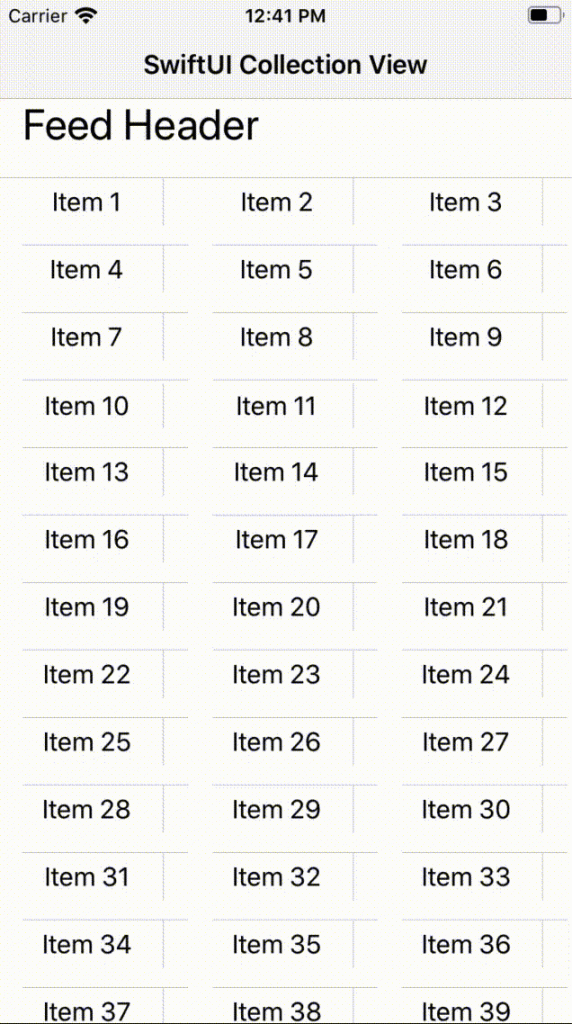SwiftUI, Combine and UICollectionView using Diffable DataSource and Compositional Layout
Apple released SwiftUI and Combine on last year WWDC 2019. It has been very exciting to see native declarative way to build apps. But unfortunately SwiftUI is missing a key UI component modern apps use quite a lot, the UICollectionView. Another WWDC is on the door and I am as excited as everyone else on what Apple does with SwiftUI 2.0. May be we’ll finally get native SwiftUI CollectionView with that. But until then, using UIViewRepresentable or UIViewControllerRepresentable is the only solution for now.
The target result
The final result of this example will look the following. A SwiftUI CollectionView with SwiftUI View cell, header and footer and the ability to pull to refresh and paginate.

Shiny iOS 13 UIKit APIs
With all the excitement revolving SwiftUI and Combine, a lot of iOS enthusiast almost missed a significant improvement on UIKit. Specifically in UICollectionView: UICollectionViewDiffableDataSource and UICollectionViewCompositionalLayout. Now these two APIs have made using UICollectionView way easier than before, eliminating the usage of nasty update blocks inside delegate methods. Like SwiftUI and Combine, these two APIs also require iOS 13.0 as minimum deployment target. This makes these the perfect candidates to create a SwiftUI wrapper view for the missing collection view.
A typical collection view
A fairly common collection view use-case will have the following behaviors, that we’ll need to access from our SwiftUI counter part:
- A reusable cell
- A reusable header / footer view
- A cell selection callback
- A pull to refresh callback
- A pagination/ load more callback (assuming it’s displaying something from an API endpoint)
There might be other customizations one might need for their app. But I am only focusing on the most common ones.
I have not focused on how UICollectionViewDiffableDataSource or `UICollectionViewCompositionalLayout works or how to customize them. Rather I have focused on how to use these APIs and make a declarative SwiftUI CollectionView.
Combine Replacing Delegates: The Declarative Way
Now if I was going with the typical imperative approach, I’d have used some delegate methods like following to send the corresponding event updates.
protocol FeedViewControllerDelegate: AnyObject {
func feed(
_ feed: UIViewController,
didSelectItemAtIndexPath indexPath: IndexPath
)
func feed(
_ feed: UIViewController,
didPullToRefresh completion: @escaping (() -> Void)
)
func feedShouldLoadMore(_ feed: UIViewController)
}
But as promised I’ll be using declarative approach using the power of Combine Framework. So I’ll be replacing our delegate methods using Publishers, more specifically PassthroughSubject.
typealias PullToRefreshCompletion = () -> Void
private let loadMoreSubject: PassthroughSubject<Void, Never>?
private let itemSelectionSubject: PassthroughSubject<IndexPath, Never>?
private let pullToRefreshSubject: PassthroughSubject<PullToRefreshCompletion, Never>?
And instead of calling the delegate methods I’d be sending publisher events as following:
...
// pagination
section.visibleItemsInvalidationHandler = {
[weak self] visibleItems, _, _ in
guard let self = self,
let row = visibleItems.last?.indexPath.row else { return }
// sending prefetch subscription notice for pagination
if self.items.count - self.prefetchLimit > 0,
row >= self.items.count - self.prefetchLimit {
guard !self.isPaginating else { return }
self.isPaginating = true
self.loadMoreSubject?.send()
}
}
...
// didSelectItem
func collectionView(
_: UICollectionView,
didSelectItemAt indexPath: IndexPath) {
itemSelectionSubject?.send(indexPath)
}
...
// pull to refresh
@objc private func pullToRefreshAction() {
pullToRefreshSubject?.send {
self.collectionView.refreshControl?.endRefreshing()
}
}
...
The FeedView: A SwiftUI CollectionView
To make this work I’ll be pushing the publisher dependencies as constructor injection: for SwiftUI wrapper to FeedCollectionViewController. So our UIViewControllerRepresentable will look something like this:
struct FeedView: UIViewControllerRepresentable {
...
init(
...
loadMoreSubject: PassthroughSubject<Void, Never>? = nil,
itemSelectionSubject: PassthroughSubject<IndexPath, Never>? = nil,
pullToRefreshSubject: PassthroughSubject<PullToRefreshCompletion, Never>? = nil,
...
) {
...
self.loadMoreSubject = loadMoreSubject
self.itemSelectionSubject = itemSelectionSubject
self.pullToRefreshSubject = pullToRefreshSubject
...
}
func makeUIViewController(context _: Context) -> FeedViewController {
FeedViewController(
...
loadMoreSubject: loadMoreSubject,
itemSelectionSubject: itemSelectionSubject,
pullToRefreshSubject: pullToRefreshSubject,
...
)
}
func updateUIViewController(
_ view: FeedViewController,
context _: Context
) {
view.updateSnapshot(items: items)
}
}
The updateSnapshot(items:) method is a crucial method for FeedViewController. Because that’s the one that’ll update our diffable datasource snapshot of the UICollectionView.
func updateSnapshot(items: [FeedViewModel]) {
self.items = items
var snapshot = NSDiffableDataSourceSnapshot<Section, FeedViewModel>()
snapshot.appendSections([.main])
snapshot.appendItems(items)
dataSource.apply(snapshot, animatingDifferences: false)
}
Now we can use our FeedView in a SwiftUI content as:
FeedView(
...,
loadMoreSubject: interactor.loadMoreSubject,
itemSelectionSubject: interactor.itemSelectionSubject,
pullToRefreshSubject: interactor.pullToRefreshSubject,
...
)
.onReceive(interactor.loadMoreSubject, perform: { [weak self] in
self?.interactor.loadMore()
})
.onReceive(interactor.itemSelectionSubject, perform: { [weak self] in
self?.selectedItemName = self?.interactor.items[$0.row].name
})
.onReceive(interactor.pullToRefreshSubject, perform: { [weak self] completion in
self.interactor.refresh().sink {
completion()
}
.store(in: &self.interactor.cancellables)
})
.onDisappear {
self.interactor.cancellables.removeAll()
}
Final words
I have put all these concepts together to create a single view application. You can found the complete implementation in my GitHub Repo.
Feel free to modify or adjust as your need. This example can be further extended using Swift Generics to create a fully customizable collection view replacement for SwiftUI. May be I’ll talk about it some other day. Happy Coding!
